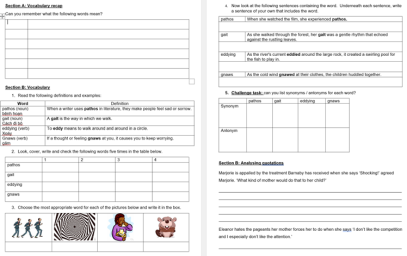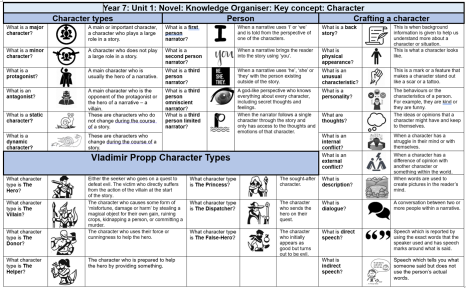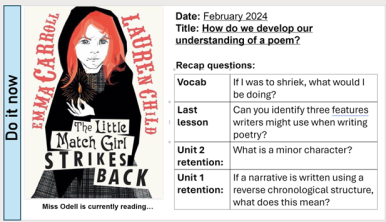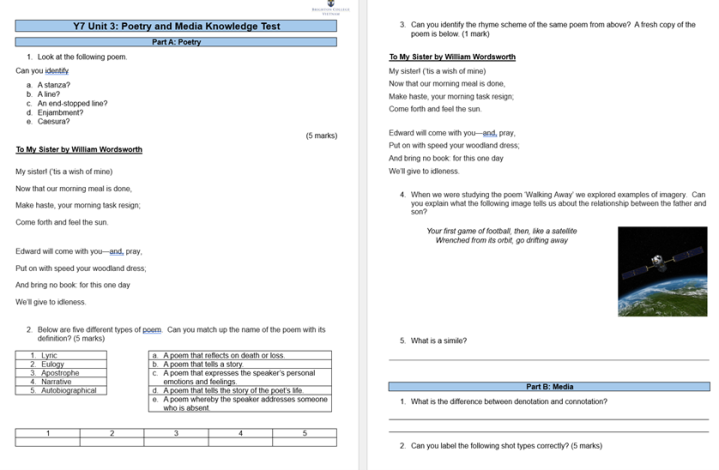I’ve been in teams where members feel like cogs, depersonalized and deskilled because they are not involved in a process and not thanked, appreciated, or asked. Where communication is one-way, ill-considered and, at times, demeaning.
This is the opposite of what we want for our teams and our staff.
As a new leader, starting my position officially in August as Head of IB and SLT, I am spending a lot of time strategically thinking about how I create the strongest IB collective in our school. As a result, I am avidly reading a lot of Leadership books. The Power of Teams by Sam Crome is one such exceptional read and a read I am carrying around with me a lot.
This is blog number one of many because there is sooooo much to take away but I find blogging such a useful practice to distil what I have read and reflect upon given my context. So this blog post is going to consider collective purpose and the power of cohesive, joined-up strategic thinking.
- Collective purpose
‘Teaming is a perpetual state of calculated selflessness’ (Hawk and Amaechi, 2010)
‘Compelling direction’, ‘Clarity of purpose’
In order for teams to be successful, there needs to be a clear purpose in what we want to do and why. Upon reflection, this is complex when you are starting a new school because there is so much that needs to be done for good reason. This is where, I think, clarity is key. Clarity in what the core priorities are (and there should be as few as possible), why these are the core priorities and how those core priorities are going to be achieved.
The establishment of core priorities is key, obviously. But again, I am thinking about the challenges of this with a very new SLT team. Each team member is going to arrive with their own core priorities and agendas and desires to push these through.
This is where the calculated but articulated selflessness has to come in. We all have to agree on a core priority and see our roles through that lens if we are to create meaningful and impactful work for our pupils and our organisation.
This year, our core priority has been Literacy with everyone feeding into this. However, next year, it has to also be gaining our IB authorisation status. This is because the philosophy and culture that lies at the heart of becoming an IB school will determine the philosophy and the culture of the rest of our school. It will affect the academics in KS4 and KS3; it will affect our approaches to Teaching and Learning and it will impact our pastoral work as well.
Therefore the challenge I have ahead of me is ensuring that everyone – those around the SLT table and those in the staffroom – are aligned with this as a core priority so that people are feeding in and not diverting away from or being distracted by something else. It is only when we all feed into our core business and not divert from it that what we do can be strong and impactful and ultimately successful. The cohesion of the team is absolutely critical and central to this.
- Cohesion
‘Shared mindset’, ‘Direction’
The organisation’s overall objectives, the team’s collective objectives and lastly the objectives of individuals within that team.
I spent a lot of time talking about cohesion at my old school. The importance of having joined up thinking. Too many schools I have seen work in different tangents and therefore weaken the progress they could potentially make. Too many schools choose to focus on Assessment one year, Literacy the next, Metacognition after that…when really what we need is careful, strategic, joined up thinking and time for implementation from a variety of angles.
This is achieved by establishing the core purpose through the School’s Development Plan and then supporting departments and individuals to be aligned with it through the work they do – all of which require strategic planning, thought, time and support.
I am going to use the work we are doing with Literacy as an example of what this looks like.
Step 1: Whole school focus
Establishing a core purpose for the school is step one. Our core purpose this year is literacy. The EAL need is higher than we anticipated so we are having to think about how we support our pupils with their language learning more alongside their content learning. The WHY is clear for all to see, it is tangible in the every day.
Step 2: Whole school work
Having decided the priority, the school – our Assistant Headteacher: Learning and Teaching and our Head of EAL – created a Literacy toolkit that has been shared with all staff. This has broken down our literacy work into four key areas with some strategy suggestions, which are gone through in weekly CPD sessions that sees all staff – prep and senior working together. So articulating the priority area but also the steps and strategies that need to be considered as a staff body is key.

Step 3: Department feed in
The toolkit provides the clarity to staff about what our approach to literacy is, as a school, and the CPD sessions help to unpick the strategies and practicalities around it.
However, this is not where it stops.
Our Assistant Headteacher: Learning and Teaching and our Deputy Head Academic then ensure departments are aligned with the purpose and thinking about what aspect of it is most significant for their development. Doing everything in this toolkit, for example, is impossible in Year 1 so departments should be given the time to consider from their standpoint what is the most significant, important, useful area to develop within their area. HODs are directed to ensure that the core school priority focus is a standing item on their departmental agenda so that across the year, there is a sustained focus with recognised action and development. Line Management meetings are an opportunity to feedback on the work being undertaken, a discussion to ensue and a consideration of the impact and actions for moving forward.
If every department feeds into just one area of the toolkit, the core priority is being thought about, developed and strengthened in a variety of ways.
Department: English
So, if I take English as an example, we have established that a core area of focus for us is the development of Tier two vocabulary. The lexile ranges of our pupils are quite low so the HOD and I have had extensive discussions about this data and what we can do to approach building our pupils’ vocabulary. Therefore, rather than tackle all of the school’s Literacy Toolkit, we choose to focus in on Vocabulary development. We have then identified two tangible actions:
- We have introduced Readtheory, which tracks the lexile levels but works in an adaptive way to support the development of vocabulary over time.
- We have introduced a vocabulary activity each week as part of our Language lesson. We introduce 4 new tier 2 words – most often taken from the texts being studied – we say them, define them, spell them, match them to images, see them in context and construct our own examples. We recap these key words as part of our Do Now retrieval tasks so we are constantly revisiting them.


These two actions have been the focus of our work across Year 1. Our HOD reports back to the Deputy Head Academic on the work that English are doing and he and the Assistant Headteacher: Learning and Teaching receive similar feedback from other departments to establish each departmental focus and the actions being taken before considering the impact at the end of the year.
Two things needs to be considered: ongoing development and sharing of best practice.
Is a year enough to work on this as a departmental focus? Of course, not so the work carries on in English next year but it enters into the building year rather than the creation year, where tweaks and developments are made rather than starting something from scratch, which allows for us to focus on the creating and thinking stage for our second core priority.
For example, we have chosen the vocabulary as we go along this year, mainly from texts studied. Next year, this can be more strategically considered using the vocabulary tracker we compiled this year. We need to increase the visibility of the words so now we know which words we want to target, we can create termly word walls. We need to embed the words into our termly Knowledge Test and then include them in our final written assessments too. All of these are easier to do now our vocabulary lists have been thought about and created and readtheory has been embedded and our vocabulary lesson structure has been perfected.
Secondly, to ensure momentum and focus on the core strategy, there should be regular opportunities to share the work being undertaken. The Deputy Head and Assistant Headteacher: Learning and Teaching will have liaised with HODs and will understand each department’s area of literacy focus and the work they are doing, coaching them potentially through this work. This departmental strategic thinking, implementation, reflecting, refining can then be shared across the school with departments taking a greater ownership of the training sessions to share and disseminate best practice. If departments have focused on different aspects of the toolkit this can only then strengthen the school’s approach to addressing the core priority area.
Step 4: Pastoral feed in
The success of a strategy is also as a result of utilising the different opportunities and spaces available to us. In this case, both academic and pastoral. In seeing how a core priority can be approached by a variety of different teams, we can only be strengthening our focus on our core priority.
For example, if I go back to our core priority this year of Literacy, many schools have seen tutor time as the perfect opportunity for extra, focused reading. This is something we have started to introduce using tutor time as a space for reading. The WHY for this is evident in that there isn’t a great reading culture and our reading ages are variable. In term 1, therefore our Assistant Headteacher: Learning and Teaching introduced a reading session during a Friday tutorial slot – a different space for a clear literacy focus that involves all staff. A number of our tutors have already taken it upon themselves to use the data to identify pupils to sit and read with during this time, which has been absolutely fantastic to see. Our first priority in Y1 was to build a habit in our pupils in terms of having a reading book on them and then build the habit of sustained reading for 15 minutes.
Next year, there is scope to really enhance what is done further within this space with the arrival of a Deputy Head Pastoral and Heads of Key Stage.
Step 5: Individual feed in
And finally, when we have been presented with the school’s vision and we have had table talks with our departments, individuals should then be given the space to think about an area they would like to develop. As part of the performance management review process or the school’s use of action research, one focus area should be aligned to the whole school core priority, to again give strength to the work the school is doing to address their core priority.
However, to be at its best this should be systematised. Crome shares Jim Knight’s Impact Cycle (2018) of identify, learn, improve. This is where we identify a problem we want to tackle or an area in which we want to improve. We then learn – so we read up on the research, we listen to experts, we see where something is done well and then we seek to improve what we are doing as a result. Having someone work with us during this period is of huge benefit and there is much talk about the value of instructional coaching to improve our practice. It is by far and away the best CPD I have ever received. Our line managers should, in the first instance, be discussing with us the work we are doing and the impact of this for our pupils and opportunities to share within our department are key.
So, as I reflect upon my own context once again, my own area of focus linked to our whole school strategy and of benefit to the building of our department is the development of Knowledge Organisers for our pupils in Year 7. Notice the narrowness here – Year 7 only in Year 1 – if we want to do things well, we often have to do them slowly.
This feeds into our vocabulary strand of our literacy toolkit. I have read countless blogs on how to craft a Knowledge Organiser – Jon Hutchinson, Joe Kirby, David Didau etc and have been crafting these as I go through the teaching of the curriculum for the first time. I have used a question and answer format for quizzing purposes. In fact, on Friday this week, my year 7s were using their Knowledge Organisers to quiz each other ahead of their Knowledge Test. My HOD fed back that it would be nice to have visual icons for our EAL learners so I added these in. Across the year the Knowledge Organisers have been re-organised and stripped back so that each one focuses on a key concept and a core skill. E.g.
- Term 1: Character and WHAT HOW WHY
- Term 2: Narrative and Story structures
- Term 3: Poetry and Photography and Comparison
- Term 4: Drama and to be decided 😊

However, the creation of a Knowledge Organiser is only half the work as how they are used is absolutely key. The Knowledge Organisers are used to formulate the retrieval questions at the start of each lesson using the structure Andy Tharby blogged about years ago – vocabulary, last lesson, last unit, two units ago. Constant focusing and retrieving is used with the aim of retaining the knowledge. In addition, the Knowledge Organisers are used to form the weekly blooket. Pupils love blooket. They see it as fun. We know better. And then finally, the Knowledge Organisers are used to construct the termly Knowledge Test.



And, of course, the two key areas of consideration stick: ongoing development and the sharing of best practice.
So much of the foundation with regard to Knowledge Organiser is now in place but there is still building and developmental work to do. This year, knowledge has been identified as we go. Next year, I can be much more strategic and clear from the outset. I am currently constructing our yearly knowledge book and am keen to get the Knowledge Organisers translated into Vietnamese for our parents as well, for example.
In terms of sharing best practice, aside from the departmental meeting forum, I have been fortunate enough to see this be done really well. There are two potential options here. The first is a gallery showing where the individual creates a research summary poster and this is displayed for all to see at a whole staff school event. Initially, I first saw this with the Chartered College of Teaching and then we did this at one of my previous schools, where everybody displayed their posters and their work. Nibbles and drinks were offered and this made for a lovely social event as people went round the different stalls and spoke to their colleagues about the work they were doing. The other way Is through a school Teachmeet where teachers produce a five minute presentation of the work they have been doing and other staff listen, can ask questions and later find out more, which again was a lot of fun.
Summary
So, in conclusion, the focus of this blog isn’t really about the work we have done with Literacy this year but has given me space to think about the importance of Collective Purpose and Cohesion, joined up thinking and development and reflect upon where we are and where we move to.
Having read Sam’s book and reflected, I think the following are key:
- Establishing a core whole school priority into which everyone feeds and there is little distraction from.
- A clear reasoning of why X has been established as the core priority
- The range of possibilities in addressing the core priority with specific training.
- The departmental priority aligned with the whole school priority.
- The individual focus aligned with the whole school priority.
- The visual sharing of the thinking and the work that has been undertaken in relation to the core priority across all teams and individuals and the impact of that work so that momentum continues into Y2 and the strategies build.
Interestingly, I need to sit and think about how this works with the implementation of an IB programme, which is slightly different and encompasses so many core priorities. A job for our Spring Break, which is fast approaching, thankfully! As always, would love to hear your thoughts…
